What Type of Cable Is Recommended for Network Systems?
When it comes to building a reliable and high-performance network, choosing the right type of cable makes all the difference. Whether you’re setting up a home office, upgrading your business infrastructure, or expanding your data center, your network cabling forms the foundation of your entire system.
So, what type of cable is best for your network? Let’s break it down so you can make an informed decision that balances speed, performance, and cost. Our team of experienced network cabling professionals in Santa Rosa ensures your system is equipped with the most suitable cabling for performance and reliability.
Understanding Network Cabling Basics
Network cables are the physical medium that connects your devices — computers, routers, switches, and servers — allowing them to communicate efficiently. The two main categories of network cables are Ethernet (copper) and fiber optic. Each has its own advantages depending on the type of system you’re installing.
The most common options used today include CAT5e, CAT6, CAT6a, CAT7, and fiber optic cables.
1. CAT5e: The Budget-Friendly Option
Category 5e (Enhanced) cable is an improved version of the original CAT5 standard. It supports speeds up to 1 Gbps (Gigabit Ethernet) and bandwidths up to 100 MHz.
Best for:
- Small offices or homes with basic networking needs
- Internet speeds under 1 Gbps
- Short cable runs
Pros: Affordable, widely available, easy to install
Cons: Not ideal for future upgrades or high-bandwidth applications
If your setup only requires basic connectivity for everyday use, CAT5e can still get the job done — but it’s quickly being replaced by faster options like CAT6.
2. CAT6: The Modern Standard for Most Networks
CAT6 cable has become the industry standard for most commercial and residential installations. It supports speeds up to 10 Gbps at distances up to 55 meters and bandwidths up to 250 MHz.
Best for:
- Modern offices, schools, and homes
- High-speed internet connections
- Applications like video conferencing, streaming, and cloud computing
Pros: Faster speeds, reduced interference, affordable
Cons: Slightly thicker and less flexible than CAT5e
If you’re building a new network or upgrading from CAT5e, CAT6 offers a great balance of performance and cost, making it the most recommended choice for today’s systems.
3. CAT6a: The Enhanced Performer
CAT6a (Augmented Category 6) takes performance to the next level, supporting 10 Gbps speeds up to 100 meters and bandwidths up to 500 MHz. It’s shielded to reduce crosstalk and electromagnetic interference, making it ideal for high-density environments.
Best for:
- Large offices, data centers, hospitals, and industrial facilities
- Networks that require 10 Gbps over long distances
Pros: Future-proof, highly reliable, excellent for high-speed connections
Cons: More expensive and harder to install due to thicker insulation
If you’re thinking long term, CAT6a is a solid investment for networks that demand speed, stability, and future scalability.
4. CAT7 and CAT8: For Advanced, High-Speed Systems
CAT7 and CAT8 cables are designed for next-generation networks. CAT7 supports up to 10 Gbps at 100 meters with 600 MHz bandwidth, while CAT8 can reach 25–40 Gbps at shorter distances (up to 30 meters).
Best for:
- Data centers and enterprise-level systems
- Specialized high-speed applications
Pros: Extremely fast, shielded for superior performance
Cons: Expensive, not necessary for most homes or small offices
Unless you’re running a large-scale server environment, CAT7 or CAT8 may be more than you need right now — but they’re excellent for future-proofing high-demand facilities.
5. Fiber Optic Cable: The Ultimate in Speed and Distance
Fiber optic cabling transmits data using light rather than electrical signals, offering unmatched speed and distance. It’s ideal for large networks, data centers, or any environment requiring long runs with minimal signal loss.
Types of fiber optic cables:
- Single-mode fiber (SMF): Best for long-distance connections (up to 40 km or more)
- Multimode fiber (MMF): Best for shorter distances (up to 550 meters)
Pros: Ultra-fast, immune to electromagnetic interference, supports very long runs
Cons: More expensive and requires specialized installation
If you need top-tier performance, fiber optic is the gold standard — especially for backbones in commercial buildings or multi-site networks.
Choosing the Right Cable for Your Network
When deciding which type of cable to use, consider the following factors:
- Speed requirements: What’s the maximum bandwidth your network needs?
- Distance: Longer runs may require fiber or higher-category copper cables.
- Environment: Shielded cables are best for areas with electrical interference.
- Budget: CAT6 provides great value for most installations.
- Future upgrades: It’s more cost-effective to install higher-grade cables now than to replace them later.
For most modern installations, CAT6 or CAT6a cables are the most recommended choices for balancing performance, reliability, and affordability.
Why Professional Installation Matters
Even the best cable won’t perform properly if it’s installed incorrectly. Professional network cabling installers ensure:
- Proper termination and labeling
- Compliance with TIA/EIA and California building codes
- Minimal interference through proper cable routing
- Certified testing and documentation
Hiring a qualified installer guarantees your network runs efficiently from day one and remains reliable for years to come. Cable length also affects network efficiency — find out how long a LAN cable can be before performance starts to degrade.
Final Thoughts
The right cable choice depends on your specific needs — but for most home and business networks, CAT6 or CAT6a offers the best combination of speed, reliability, and future-proofing. For high-performance or long-distance setups, fiber optic cabling remains the top recommendation.
If you’re unsure which cable is best for your setup, contact a certified network cabling professional who can assess your environment and design the perfect solution.
